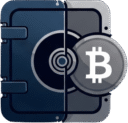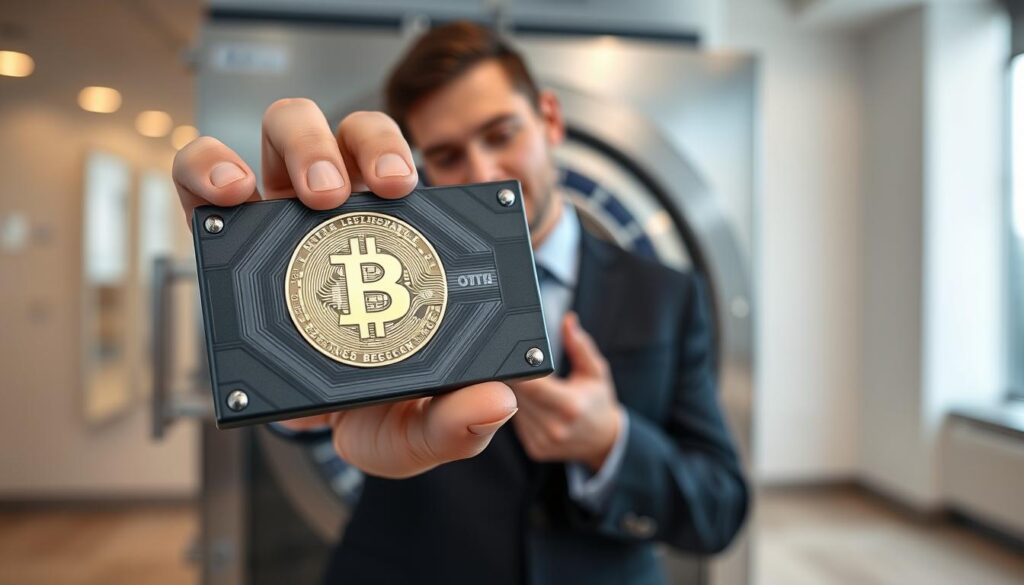The rapid rise in Bitcoin’s popularity has unfortunately been accompanied by a surge in crypto-related scams and fraud. In 2023 alone, losses related to crypto fraud increased by 45% year-over-year, reaching a staggering $5.6 billion based on 69,000 complaints. While Bitcoin offers revolutionary technology and financial freedom, its decentralized nature also makes it attractive to criminals seeking to exploit the unwary.
The good news? With proper education and security practices, you can confidently take control of your Bitcoin through self-custody while protecting yourself from potential threats. This guide will walk you through essential security measures, common scams to avoid, and best practices that even experienced Bitcoin enthusiasts sometimes overlook.
Why Bitcoin Self-Custody Matters
Taking control of your Bitcoin through self-custody offers true ownership and security
Bitcoin was designed as a peer-to-peer electronic cash system that eliminates the need for trusted third parties. When you keep your Bitcoin on exchanges or custodial services, you’re essentially trusting those companies with your assets—which contradicts Bitcoin’s fundamental purpose.
Self-custody means you alone control the private keys that grant access to your Bitcoin. As the popular saying goes: “Not your keys, not your coins.” When you practice self-custody, no one can freeze your funds, restrict your transactions, or lose your Bitcoin through mismanagement or bankruptcy.
However, self-custody also means taking full responsibility for your security. There’s no customer support to call if you lose access to your private keys or fall victim to a scam. This is why understanding proper security practices is essential before transitioning to self-custody.
“Whoever controls your keys, ultimately controls your bitcoin. Not your keys; not your coins!”
The Value Threshold Approach to Bitcoin Wallets
When deciding which wallet solution to use for self-custody, consider how much value you plan to store. Like learning to swim, it’s best to start in the shallow end (mobile wallet) before diving into deeper waters (hardware wallets) or the ocean (multisig setups).
| Wallet Type | Recommended Value Threshold | Physical Comparison |
| Mobile or Software Wallets | $1 — $300 | Like a wallet for carrying petty cash and cards |
| Single Signature Hardware Wallet | $300 — $75,000 | Like a home safe with a single PIN or combination |
| Multisignature Hardware Wallet Setup | $75,000+ | Like a bank vault with multiple security layers |
Understanding Common Crypto Scams
Before diving into self-custody practices, it’s crucial to understand the threats you might face. Crypto-related scams aren’t a single type of fraud but rather an umbrella term covering everything from small personal thefts to massive exchange hacks.

Common Bitcoin scams target both newcomers and experienced users
Phishing Attacks
What it is:
Scammers impersonate trusted entities like crypto exchanges or wallet providers to steal your private keys or seed phrase. They create fake websites that look nearly identical to legitimate ones, hoping you’ll enter your sensitive information.
How it works:
You might receive emails, social media messages, or even text messages with links to these fake websites. The sites often have URLs that are slightly different from the legitimate ones (like “ledqer.com” instead of “ledger.com”).
How to protect yourself:
- Always double-check URLs character by character before entering any information
- Bookmark official websites instead of clicking links from emails
- Never share your seed phrase or private keys with anyone, even if they claim to be support staff
- Enable two-factor authentication on all your accounts
- Consider using a hardware wallet that requires physical confirmation for transactions
Warning: No legitimate company will ever ask for your seed phrase or private keys. If anyone requests this information, it’s a scam—100% of the time.
Ponzi Schemes and High-Yield Investment Programs (HYIPs)
What it is:
These fraudulent schemes promise unrealistically high returns on your Bitcoin investments. Early investors are paid with funds from new investors, creating the illusion of legitimacy until the scheme eventually collapses.
How it works:
Promoters often use social media to advertise “guaranteed” returns or passive income opportunities. They might claim to have special trading algorithms or mining operations that generate exceptional profits.
How to protect yourself:
- Remember that if something sounds too good to be true, it probably is
- Be skeptical of guaranteed returns—all investments carry risk
- Research projects thoroughly before investing any Bitcoin
- Check if the project has verifiable team members with real identities
- Look for transparent operations and clear explanations of how returns are generated
Rug Pulls and Exit Scams

Rug pulls occur when developers suddenly abandon a project after raising funds
What it is:
Developers create a seemingly legitimate crypto project, build hype around it, then suddenly abandon the project and disappear with investors’ funds. This often happens with new tokens or NFT projects.
How it works:
Scammers heavily promote their project through social media and influencers, creating FOMO (fear of missing out). Once enough people have invested, they drain the liquidity pools or sell their pre-mined tokens, leaving investors with worthless assets.
How to protect yourself:
- Stick to established projects with proven track records
- Research the development team thoroughly—anonymous teams are a red flag
- Check if the project’s code is open-source and has been audited
- Be wary of projects with excessive marketing but limited technical details
- Start with small investments to test the waters before committing larger amounts
Strengthening Security with Two-Factor Authentication (2FA)
Two-factor authentication (2FA) adds an essential layer of security to your Bitcoin accounts by requiring two different types of verification before granting access. Even if someone obtains your password, they still can’t access your account without the second factor.
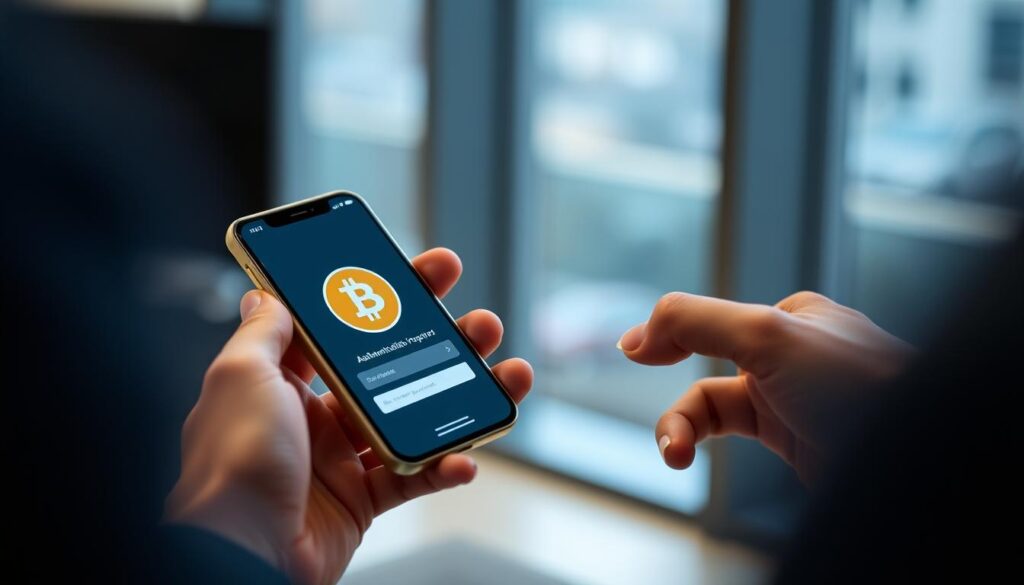
Using an authenticator app provides stronger security than SMS-based 2FA
Types of 2FA (From Least to Most Secure)
- Verification codes sent via text message
- Vulnerable to SIM swapping attacks
- Can be intercepted by sophisticated attackers
- Better than no 2FA, but not recommended for high-value accounts
SMS-Based 2FA
- Apps like Google Authenticator or Authy
- Generate time-based codes on your device
- Not vulnerable to SIM swapping
- Requires physical access to your device
- Recommended for most Bitcoin accounts
Authenticator Apps
- Physical devices like YubiKey or Trezor
- Requires physical presence to authenticate
- Immune to phishing and remote attacks
- Most secure option available
- Recommended for high-value accounts
Hardware Security Keys
Setting Up 2FA on Common Bitcoin Platforms
Most reputable Bitcoin exchanges and wallet services offer 2FA options. Here’s how to set it up on some popular platforms:
Exchanges (Coinbase, Kraken, etc.)
- Log in to your account and navigate to security settings
- Look for “Two-Factor Authentication” or “2FA” options
- Choose your preferred method (authenticator app recommended)
- Scan the QR code with your authenticator app
- Enter the verification code to confirm setup
- Save backup codes in a secure location
Self-Custody Wallets
- Open your wallet application and go to settings
- Look for security or authentication options
- Enable 2FA if available (not all self-custody wallets offer this)
- For hardware wallets, 2FA is built into the device verification process
- Consider using a passphrase (25th word) for additional security
Pro Tip: When setting up 2FA with an authenticator app, immediately back up your recovery codes or the app’s backup method. If you lose your phone, these codes will be your only way to regain access to your accounts.
Operational Security (OpSec) Best Practices for Bitcoin Self-Custody
Operational security, or OpSec, refers to the practices that protect your Bitcoin from unauthorized access. This includes both digital and physical security measures to create a layered defense strategy.

A comprehensive security setup includes hardware wallets and secure backup solutions
Cold Storage vs. Hot Wallets
Hot Wallets (Online)
Hot wallets are connected to the internet, making them convenient for frequent transactions but more vulnerable to attacks. These include mobile wallets, desktop wallets, and exchange accounts.
Advantages
- Convenient for everyday transactions
- Easy to set up and use
- Often free to download and use
Disadvantages
- Vulnerable to malware and hacking
- Private keys stored on internet-connected devices
- Not suitable for storing large amounts
Cold Storage (Offline)
Cold storage solutions keep your private keys completely offline, significantly reducing the risk of remote attacks. Hardware wallets are the most popular form of cold storage.
Advantages
- Maximum security against online threats
- Private keys never exposed to internet
- Suitable for long-term storage of larger amounts
Disadvantages
- Less convenient for frequent transactions
- Hardware wallets cost money ($50-$200)
- Requires physical security measures
Secure Seed Phrase Management
Your seed phrase (sometimes called recovery phrase or mnemonic) is a series of 12-24 words that can restore access to your Bitcoin wallet. Protecting this phrase is absolutely critical—anyone who has it can access your funds.
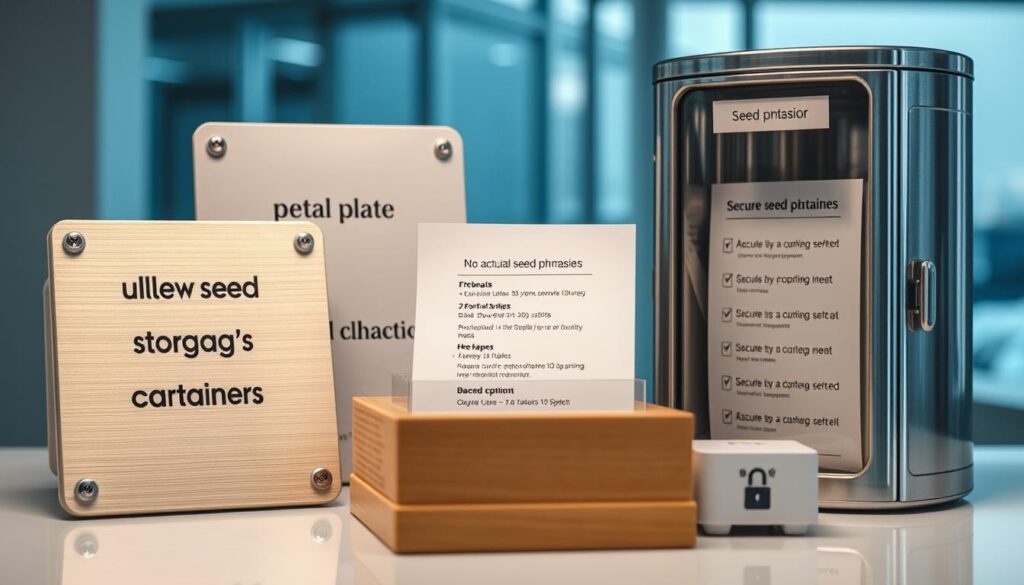
Metal backups provide protection against fire, water, and physical degradation
DO:
- Write your seed phrase on paper or stamp/engrave it on metal
- Store backups in multiple secure locations
- Consider using a metal backup solution for fire/water resistance
- Test your backup by performing a recovery before storing significant funds
- Consider advanced solutions like multisig or seed splitting for large amounts
DON’T:
- Take photos of your seed phrase
- Store it in digital format (email, cloud storage, password managers)
- Share it with anyone, including support staff
- Store it without testing recovery first
- Keep it in obvious locations like desk drawers
Seed Phrase Test: Before storing significant funds in a new wallet, send a small test amount, then completely reset the wallet and recover it using your seed phrase backup. If the test amount appears in your recovered wallet, your backup is working correctly.
Device Security Measures
The security of your devices plays a crucial role in protecting your Bitcoin, especially if you use software wallets or access exchanges from these devices.
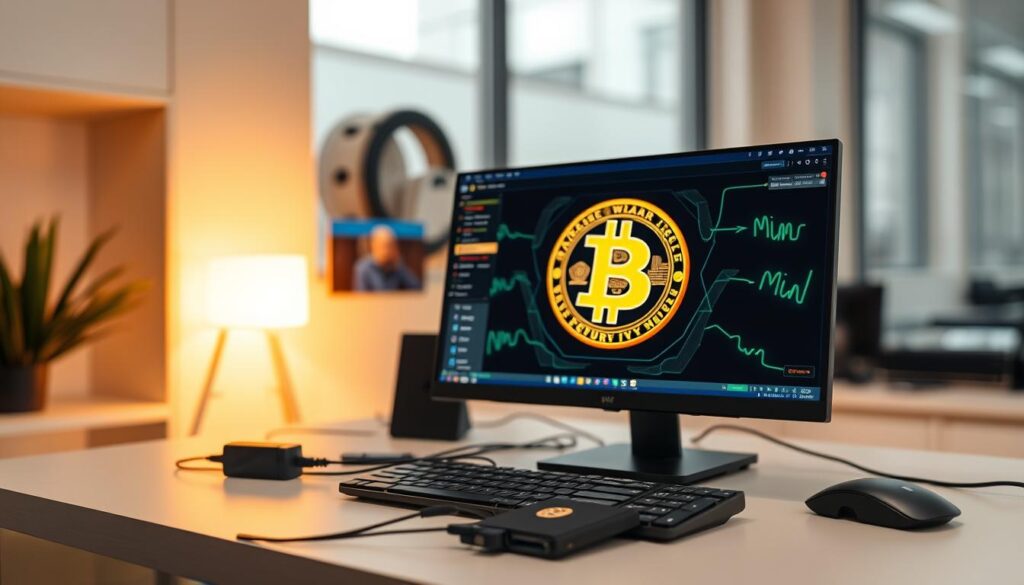
A secure computing environment is essential for Bitcoin transactions
- Keep software updated: Always install security updates for your operating system, browsers, and wallet applications
- Use antivirus and anti-malware: Scan your devices regularly for malicious software
- Enable device encryption: Encrypt your hard drive to protect data if your device is stolen
- Use strong, unique passwords: Consider a password manager to generate and store complex passwords
- Consider a dedicated device: For large holdings, a dedicated computer used only for Bitcoin transactions provides extra security
- Be cautious with public Wi-Fi: Use a VPN when accessing Bitcoin accounts on public networks
Step-by-Step Guide to Bitcoin Self-Custody
Now that you understand the security principles, let’s walk through the practical steps to set up and maintain a secure self-custody solution for your Bitcoin.
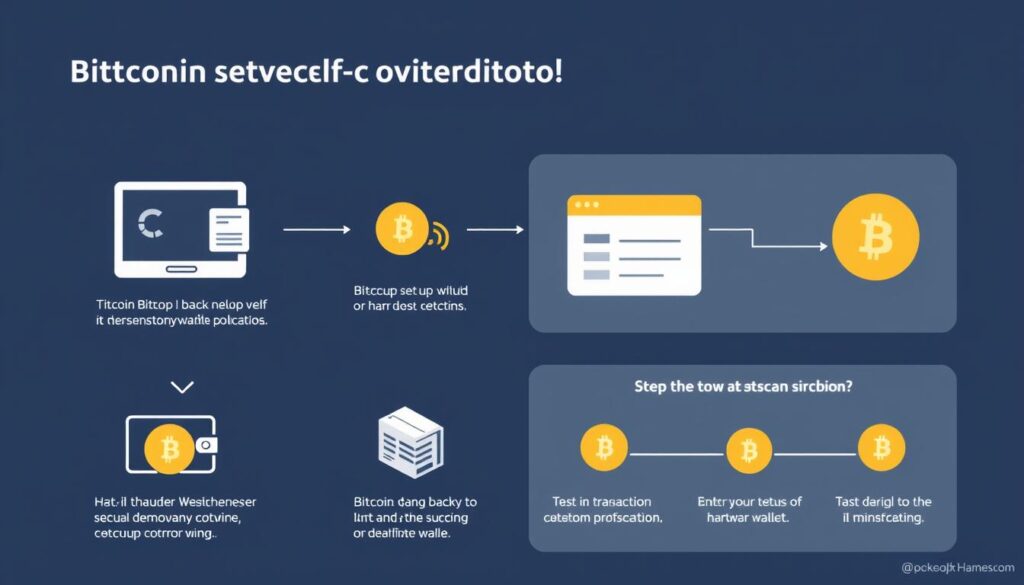
The self-custody process involves several key steps to ensure security
Step 1: Choose the Right Wallet
Select a wallet based on your security needs and the amount of Bitcoin you plan to store. For significant amounts, a hardware wallet is strongly recommended.
| Wallet Type | Recommended For | Popular Options |
| Mobile Wallet | Small amounts, beginners, frequent transactions | Blue Wallet, Muun, Blockstream Green |
| Hardware Wallet | Larger amounts, long-term storage | Ledger, Trezor, Coldcard, Foundation |
| Multisignature Setup | Very large amounts, institutional storage | Unchained Capital, Casa, Nunchuk |
Step 2: Set Up and Secure Your Wallet
- Purchase your wallet directly from the manufacturer (never buy used)
- Follow the manufacturer’s setup instructions carefully
- Create a new wallet (don’t import an existing one yet)
- Set a strong PIN or password for device access
- Write down your seed phrase exactly as shown, double-checking each word
- Verify your seed phrase by entering it back into the device when prompted
- Store your seed phrase backup securely (consider metal backup for important holdings)
Step 3: Test Your Setup with a Small Transaction

Always verify your setup with a small test transaction before transferring larger amounts
- Generate a receiving address on your new wallet
- Send a small amount of Bitcoin (e.g., 0.001 BTC) from your exchange or existing wallet
- Confirm that the transaction appears in your new wallet
- Optional but recommended: Send a tiny amount back to verify sending functionality
Important: Always verify the receiving address carefully before sending any Bitcoin. Compare the first and last few characters to ensure accuracy.
Step 4: Test Your Recovery Process
Before storing significant amounts, verify that your seed phrase backup works correctly:
- Reset your wallet to factory settings (follow manufacturer instructions)
- Go through the recovery process using your seed phrase backup
- Verify that your test transaction is visible in the restored wallet
- If successful, you can now confidently transfer larger amounts
Step 5: Implement Regular Security Practices
- Keep your wallet firmware updated
- Periodically check your backup for degradation
- Consider creating a detailed inheritance plan for your Bitcoin
- Stay informed about security best practices and emerging threats
- Never discuss the amount of Bitcoin you own or where you store it
Advanced Security Considerations
As your Bitcoin holdings grow, you might want to implement more sophisticated security measures to protect your assets.
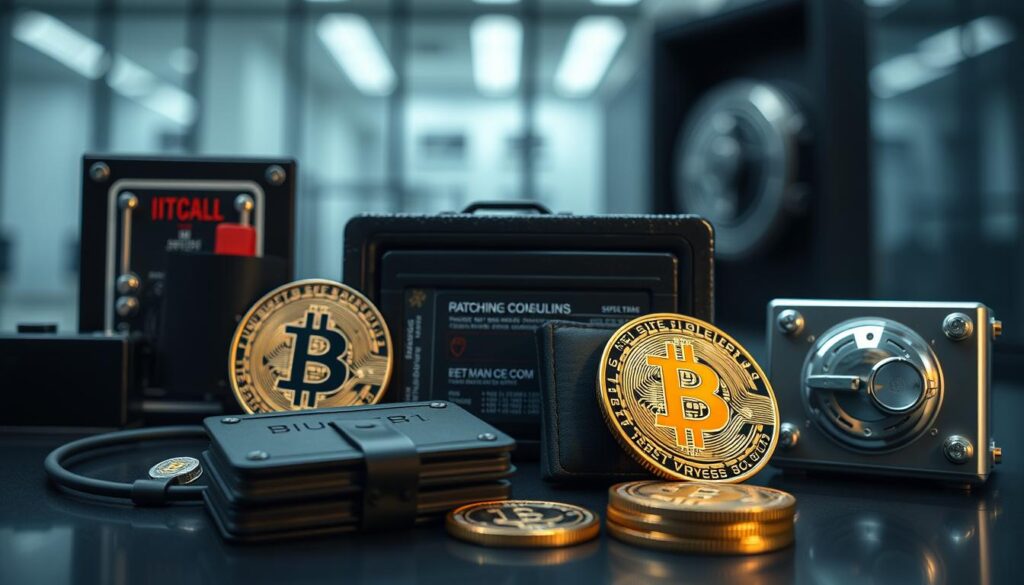
Advanced security often involves multiple layers of protection
Multisignature Wallets
Multisignature (multisig) wallets require multiple private keys to authorize a transaction. For example, in a 2-of-3 setup, you need any 2 of 3 possible keys to move funds.
Advantages
- Protection against single points of failure
- Keys can be distributed across different locations
- Allows for inheritance planning and shared custody
Considerations
- More complex setup and management
- Requires backing up multiple keys and recovery information
- Additional backup requirements beyond seed phrases
Important Multisig Note: With multisig wallets, you must back up not only each seed phrase but also the wallet configuration file or extended public keys (xpubs). Without this information, you won’t be able to reconstruct your wallet even with all seed phrases.
Inheritance Planning
Without proper planning, your Bitcoin could be lost forever if something happens to you. Consider these approaches:
- Dead man’s switch: Automated systems that require periodic check-ins
- Split seed phrase: Dividing your seed phrase among trusted individuals
- Detailed instructions: Secure, encrypted instructions for heirs
- Professional services: Specialized Bitcoin inheritance services

Proper inheritance planning ensures your Bitcoin remains accessible to your heirs
Physical Security Considerations
Digital security is only part of the equation. Physical security is equally important:
- Store hardware wallets and backups in secure locations (safes, safety deposit boxes)
- Consider geographic distribution of backups to protect against localized disasters
- Maintain privacy about your Bitcoin holdings to avoid becoming a target
- Be aware of potential surveillance when purchasing or setting up security equipment
Taking the Next Step in Your Bitcoin Self-Custody Journey
Self-custody is a journey that evolves as your knowledge and Bitcoin holdings grow. Start with the basics, practice with small amounts, and gradually implement more advanced security measures as needed.

With proper education and tools, Bitcoin self-custody becomes an empowering experience
Remember that security is not a one-time setup but an ongoing practice. Stay informed about emerging threats and evolving best practices. The Bitcoin community is constantly developing better tools and techniques for secure self-custody.
By taking control of your Bitcoin through proper self-custody, you’re not only securing your assets but also participating in Bitcoin’s revolutionary vision of financial sovereignty. The responsibility may seem daunting at first, but with education and careful implementation, you can confidently manage your own Bitcoin.
“The ability to hold your own keys and literally be your own bank is one of the many reasons that Bitcoin continues to grow in popularity around the world.”
Ready for Expert Guidance on Your Self-Custody Journey?
While this guide covers the essentials, navigating Bitcoin self-custody can be complex. Our team of security experts provides personalized advisory services to help you implement the perfect security solution for your specific needs and holdings.
Additional Resources for Bitcoin Self-Custody
Recommended Hardware Wallets
- Ledger (Nano S Plus, Nano X)
- Trezor (Model One, Model T)
- Coldcard Mk4
- Foundation Passport
- BitBox02 (Bitcoin-only)
Educational Resources
- Bitcoin.org – Choose Your Wallet
- Jameson Lopp’s Bitcoin Resources
- Andreas Antonopoulos YouTube Channel
- Bitcoin Magazine Security Guides
- River Learn Bitcoin Resources
Advanced Security Services
- Unchained Capital (Collaborative Custody)
- Casa (Key Management Solutions)
- Nunchuk (Multisig Platform)
- Custody Agents Advisory Services
- Specialized Bitcoin Security Consultants
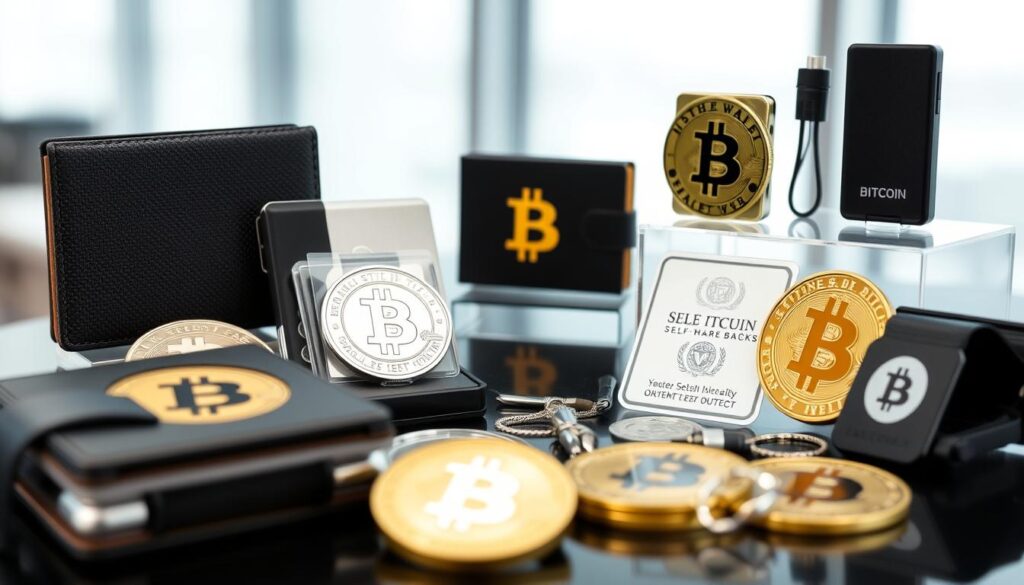
The Bitcoin self-custody ecosystem offers various solutions for different security needs
Empower Your Bitcoin Security Journey
Join our newsletter for regular updates on Bitcoin security best practices, emerging threats, and exclusive guides to enhance your self-custody setup.
